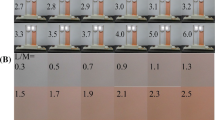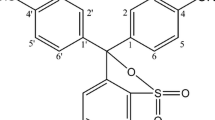Summary
The compound 2-(5-bromo-2-pyridylazo)-5-diethylaminophenol(Br-PADAP) was found capable of staining very small amounts of metals in tissue. This finding stemmed from the examination of the staining properties of pyridylazophenol analogs; 2-(2-pyridylazo)-phenol, 2-(2-pyridylazo)-5-dimethylaminophenol, 1-(2-pyridylazo)-2-naphthol, 4-(2-pyridylazo)-resorcinol, and Br-PADAP. The unusually high sensitivity of Br-PADAP is attributed to the presence of an alkylamino group at the 5-position of the benzene ring. The presence of this alkylamino group forms a charged quinoid structure, and contributes resonance and optimum solubility to the hybrid by introducing a bromine atom into the pyridine ring. We report the staining results obtained from a variety of metals and the molar absorptivity of their metal chelates.
Similar content being viewed by others
References
Anderson RG, Nickless G (1967) Metal complexes of some azo and azomethine dyestuffs Part III. Metal complexes of 2-(2-pyridylazo)phenol. Anal Chim Acta 39:469–477
Braude EA (1945) Intensities of light absorption. Nature 155:753–754
Fabian J, Hartmann H (1980) Light absorption of organic colorants, theoretical treatment and emprical rules. In: Hafner K et al. (eds) Reactivity and structure concepts in organic chemistry, vol. 12. Springer, Berlin Heidelberg New York, pp 1–2, 42–79
Gusev SI, Shchurova LM (1966) Pyridylazo compounds as metallochromic indicators. Communication 3. new azo compounds of the pyridine series and their use as indicators for the complexometric determination of bismuth. Zh Analit Khim 21:1042–1049
Horner L, Dueckheimer W (1962) Verfahren zur Herstellung von o-Chinonen. Ger. Patent No. 1, 126, 852
Horobin RW, Murgatroyd LB (1971) The staining of glycogen with Best's carmine and similar hydrogen bonding dyes. A mechanistic study. Histochem J 3:1–9
Marshall PN, Horobin RW (1973) The mechanism of action of “mordant” dyes — A study using preformed metal complexes. Histochemie 35:361–371
Shibata S, Furukawa M, Toei K (1973) Synthesis and spectrophotometric studies of azo dyes containing m-dimethylaminophenol as analytical reagents. Anal Chim Acta 66:397–409
Shibata S, Furukawa M (1974) Preparation of new chromogenic reagents which form metal complexes having a molar absorbance on the order of 105. Jpn Analyst 23:1412–1430
Sumi Y, Muraki T, Suzuki T (1980) Histochemical staining of cadmium with benzothiazolylazophenol derivatives. Histochemistry 68:231–236
Sumi Y, Muraki T, Suzuki T (1980) Histochemical staining of cadmium with benzothiazolyl-azonaphthol derivatives. Histochemistry 73:481–486
Author information
Authors and Affiliations
Rights and permissions
About this article
Cite this article
Sumi, Y., Inoue, T., Muraki, T. et al. The staining properties of pyridylazophenol analogs in histochemical staining of a metal. Histochemistry 77, 1–7 (1983). https://doi.org/10.1007/BF00496630
Received:
Accepted:
Issue Date:
DOI: https://doi.org/10.1007/BF00496630




